Is It Ok To Keep Algae On Branches In Aquarium
Algae in the aquarium might exist the greatest nuisance for every tank keeper, be information technology in a archetype social tank, an aquascape, a biotope aquarium or in convenance tanks for fish or shrimp. When confronted with an algal infestation, many aquarium keepers simply give up their beautiful hobby. However, there are good ways to get a grip on these pests, to fight them off or to prevent them from spreading.
What are algae?
The term "algae" is basically a comprehensive term for a vast number of unlike organisms. All plants non belonging to the mosses (liverworts, true mosses and hornworts) or the college plants (ferns, Lycopodiopsida and seed-bearing plants), are classified as algae. Amid them nosotros have microscopic unicellular organisms and thread-like forms too every bit the so-chosen macroscopic algae, similar seaweeds, some of which can accomplish a length of upwardly to sixty meters. For life on Earth, algae are crucial.
But like germs, i.e. viruses, bacteria and other microorganisms, the smallest algae forms are omnipresent in our environment. There are some algae that float in the air passively, the so-called aeroplankton, in gild to reach new places to inhabit. For our aquaria, this means that their omnipresence makes an aquarium that is absolutely gratis from algae practically incommunicable.
The myth of the algae-free tank
The reasons stated higher up make information technology pretty clear that algae form a function of every aquarium. There are no aquaria without any algae, despite the most dedicated care. Of form there are tanks that exercise not accept any obvious algal growth, however, we cannot run into the tiniest microscopic algae (most of them are unicellular) that are mostly present in the biofilms. Biofilms form on all the surfaces in the aquarium, and besides algae, they contain different microorganisms. They are nothing that needs to be removed, on the reverse - biofilms are all-important for the biological remainder of a tank. Moreover, many aquarium inhabitants feed on biofilm, which is great food for them.
During the cycling phase of a tank, when the biological arrangement is still finding its stability, a certain algae population is perfectly normal. Diatoms will form during the start few days to weeks, and after that, in their place, dark-green algae will form. In the long run, however, it is possible to have an aquarium without visible algae, and this is fifty-fifty realistic for starting time aquarium keepers. Just go along some basic things in mind and inform yourself about the reasons for the formation of algae.
Reasons
Every bit we accept already mentioned, particularly during the first few weeks in the life of an aquarium, the formation of algae is very probable. Frequently, the ecological residue has non yet been established in such a tank. In this example, you lot'll need to be patient until the system is balanced. The relation of algae to aquatic plants is not even so balanced in the starting time either. Stronger institute growth volition shift information technology towards the plants, at the detriment of the algae. For this reason it is rather important to outset the tank with a good plant population and to use fast-growing stem plants.
Until the tank has constitute its biological balance we recommend controlling the algae with specific measures for each kind. Start and foremost, the utilize of a sufficiently large number of algae eaters is recommendable. The most efficient algivores are Amano shrimp and nerites of the genera Vittina, Neritina and Clithon.
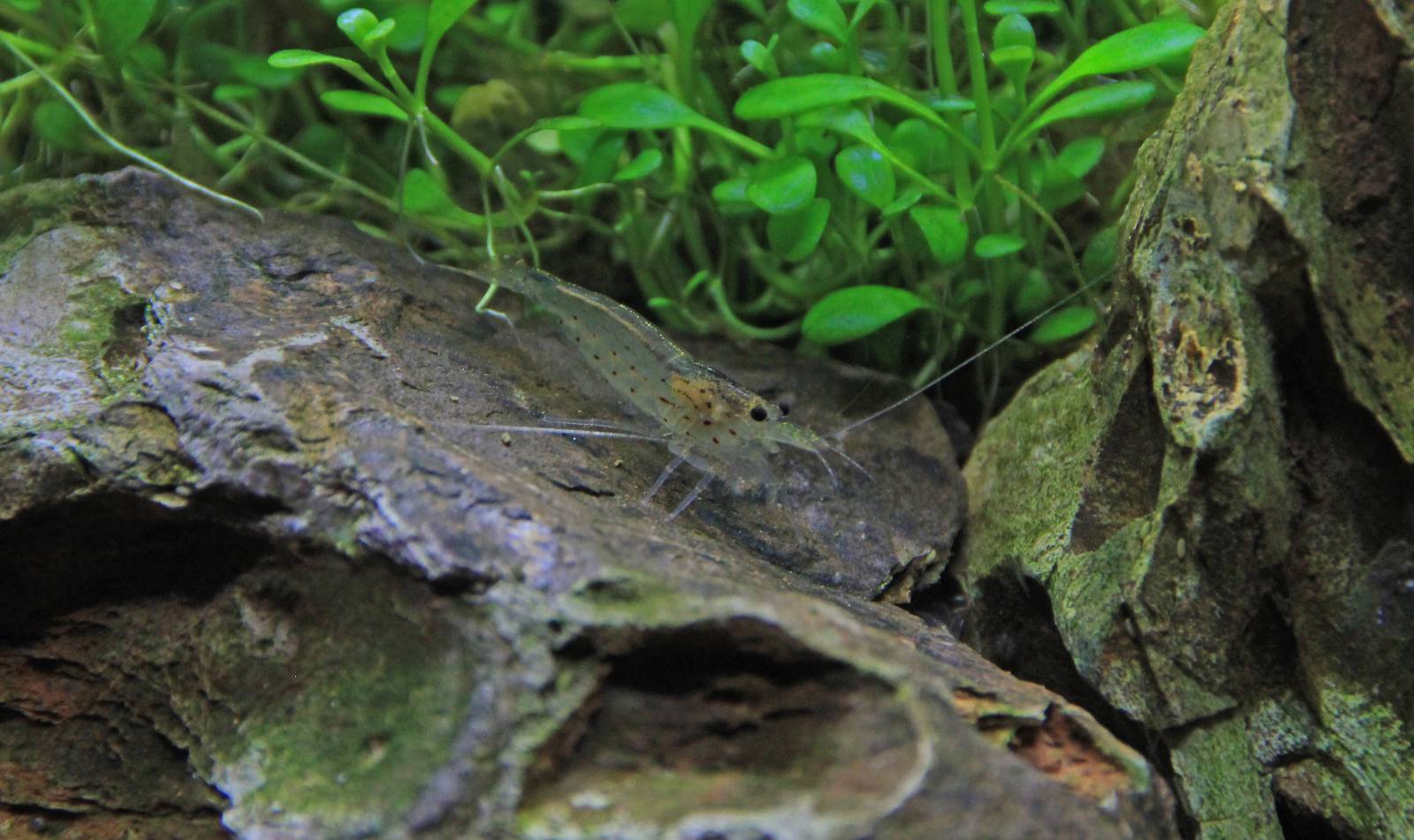
Just why will algae grade in an aquarium that has been continuing for quite a while? In a planted tank, this may happen due to a nutritional imbalance. In these cases, algae will find highly favourable conditions, which they volition employ for visible growth. We take defined "nutrients" (based on this article) as all parameters of the four basic groups comprising the elements light, COtwo, micronutrient and macronutrient fertilisation). In former times, people used to recollect that unmarried nutrients like phosphorus or nitrogen were responsible for algal growth, however, this theory has been proven wrong. In an aquarium, yous tin can find (and mensurate) nitrogen in the form of nitrate and phosphorus in the form of phosphate, for example. These nutrients are crucial for found growth, though. If they are deficient, the plants volition not grow well and cannot compete confronting the algae. A nitrate or phosphate deficiency will thus not prevent algae but tin can actually exist the cause for algal growth.
The aquarium plants need to exist supplied with the total range of nutrients with a suitable fertilising regimen, which is crucial. Of course, the nutrient supply should not only be balanced but also needs to be adjusted to the situation. For instance, plants do not need equally high levels of micronutrients (iron and trace elements) during the cycling phase of the tank as later on when the institute mass is larger. During the start weeks in the life of an aquarium yous should therefore arrange your fertiliser regime and your lighting hours to the situation. For the cycling time in a new aquascape or planted tank, we recommend the post-obit:
- A CO2 content of around xx-xxx mg/fifty, measurable by a permanent test with examination reagent
- x to 25 mg/50 of nitrate (NO3)
- 5 to 10 mg/l of potassium (G)
- 0.1 to 1 mg/l of phosphate (PO4)
- add only i/iii of the corporeality of atomic number 26 fertilizer recommended past the manufacturer
- >ten mg/l of magnesium (Mg)
- Only switch on the lights for half-dozen hours in the beginning. When the biological system in the tank runs stable and without problems you may increase the daily lighting time by half an hour per week. Under moderate to strong light, you are aiming for a daily lighting time of viii to ten hours, under less potent lite, a longer phase of 10 to 12 hours is recommendable. With the help of our light calculator you tin easily detect out which category (low/medium/strong) your lighting organisation is in.
When the aquarium plants start growing their nutrient requirements will increase, so you volition take to conform your nutrient supply to their growing needs. You can find more than detailed information in our article "fertilization during the cycling phase", which treats merely that subject.

Most nutritional imbalances and, in their wake, increased algal growth, are usually caused by slacking tank maintenance, for case if regular water changes are skipped. A regular, ideally weekly, water modify of around l% is vital for the overall development of an aquarium, and information technology may preclude algae. Likewise the add-on of fresh, unpolluted h2o, by irresolute h2o you remove unwanted substances and forestall certain elements from building up in the water. A 50% water change volition keep the nutrients for your plants at a suitable level. It prevents nutrient peaks, and you lot may even be able to do without weekly h2o tests to monitor your parameters.
However, there may be other situations that are responsible for a nutritional imbalance, like for case sloppy fecundation, lights that are besides strong or that are left on for too long, a CO2 bottle that has run empty, or even changes in the environment, like unlike light or a relocation. Even seasonal temperature fluctuations tin exist responsible for such a alter. If you discover a sudden increment of algae you showtime need to identify them correctly and then accept suitable countermeasures. In add-on you should try to find out what has acquired the infestation in the first identify and find a remedy.
Overview
In order to help yous diagnose algae correctly we have drawn upwardly a rough summary, which you lot will find in the following. In the next articles we will become into much more particular on the different types of algae, the way to command them individually and on typical reasons for algae.
Reddish algae
Red algae (Rhodophyceae) in freshwater aquaria unremarkably vest to the very broad-spread staghorn and black beard algae (BBA). Their color is not carmine past nature, they are usually grayish. Withal, they plow reddish when you immerse them in booze. This exam makes cherry-red algae very like shooting fish in a barrel to identify.
Staghorn algae

Staghorn algae (Compsopogon sp.) usually grow on the equipment, the decoration and on the veins of slow-growing aquatic plants. They hold on to their substrate quite firmly, are usually of a nighttime colour and their habit is almost wire-like or hairy (sometimes they wait like the horn of a stag, hence the name). For further information, delight go to the corresponding article.
Black beard algae (BBA)
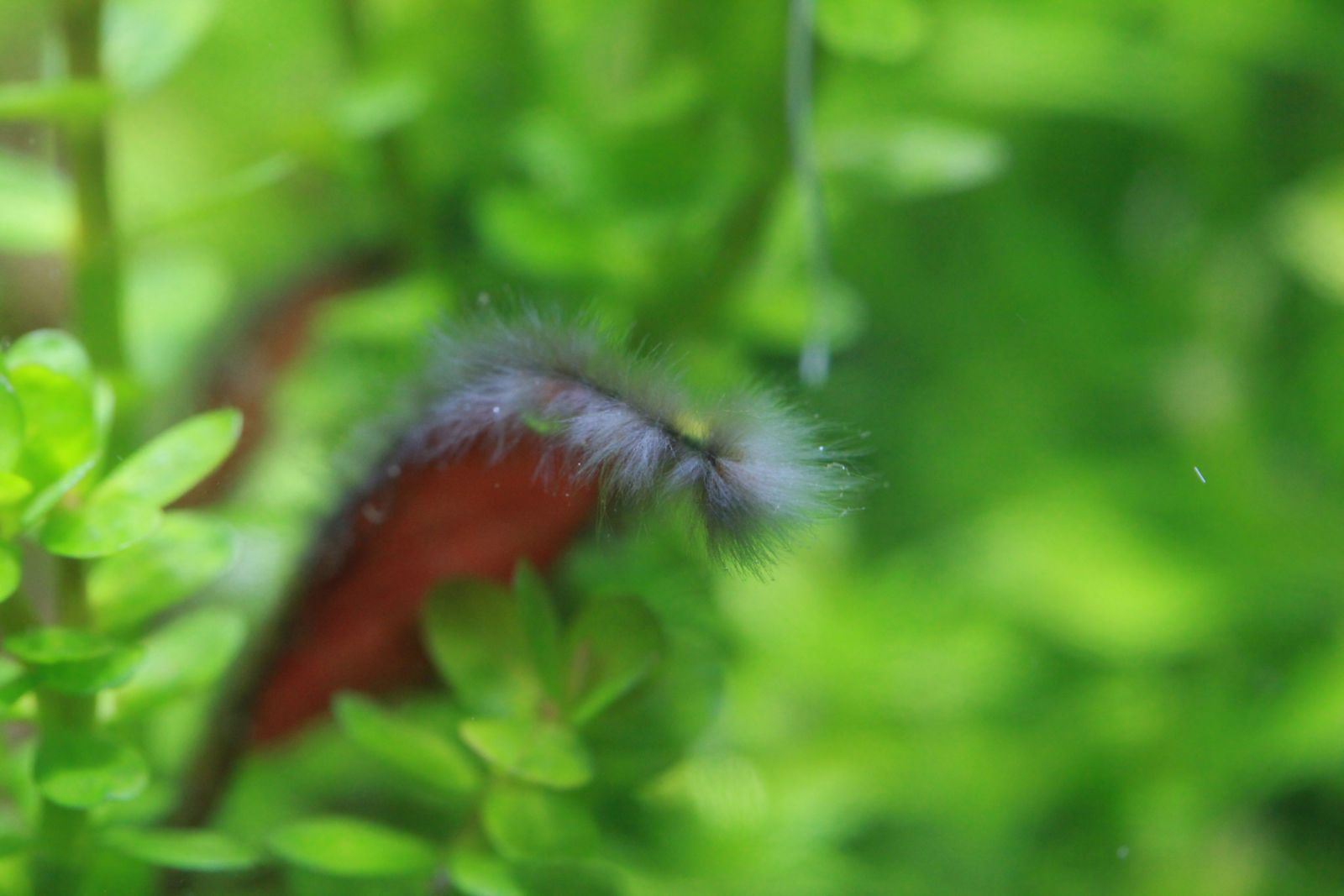
Black bristles algae (or blackness castor algae) (Audouinella sp., Rhodochorton sp.) accept a bush-like growth habit and consist of many short, densely growing filaments. They abound from one common indicate. Their forms makes them look like a tiny brush. Their color may vary from nighttime dark-green over grayness to a deep black. Exactly similar staghorn algae, castor algae usually grow on the equipment, the hardscape and on the foliage margins of slow-growing plants. There they are anchored quite strongly, and entirely removing them mechanically (by plucking them off) is almost incommunicable. Y'all tin can observe more data most these algae in this article.
Algal films
When we talk about algal films we talk about those algae that grow like a carpet, covering found leaves, the glass, the substrate, the equipment and the hardscape. Many dissimilar algae do this.
Brown algae (Diatoms)
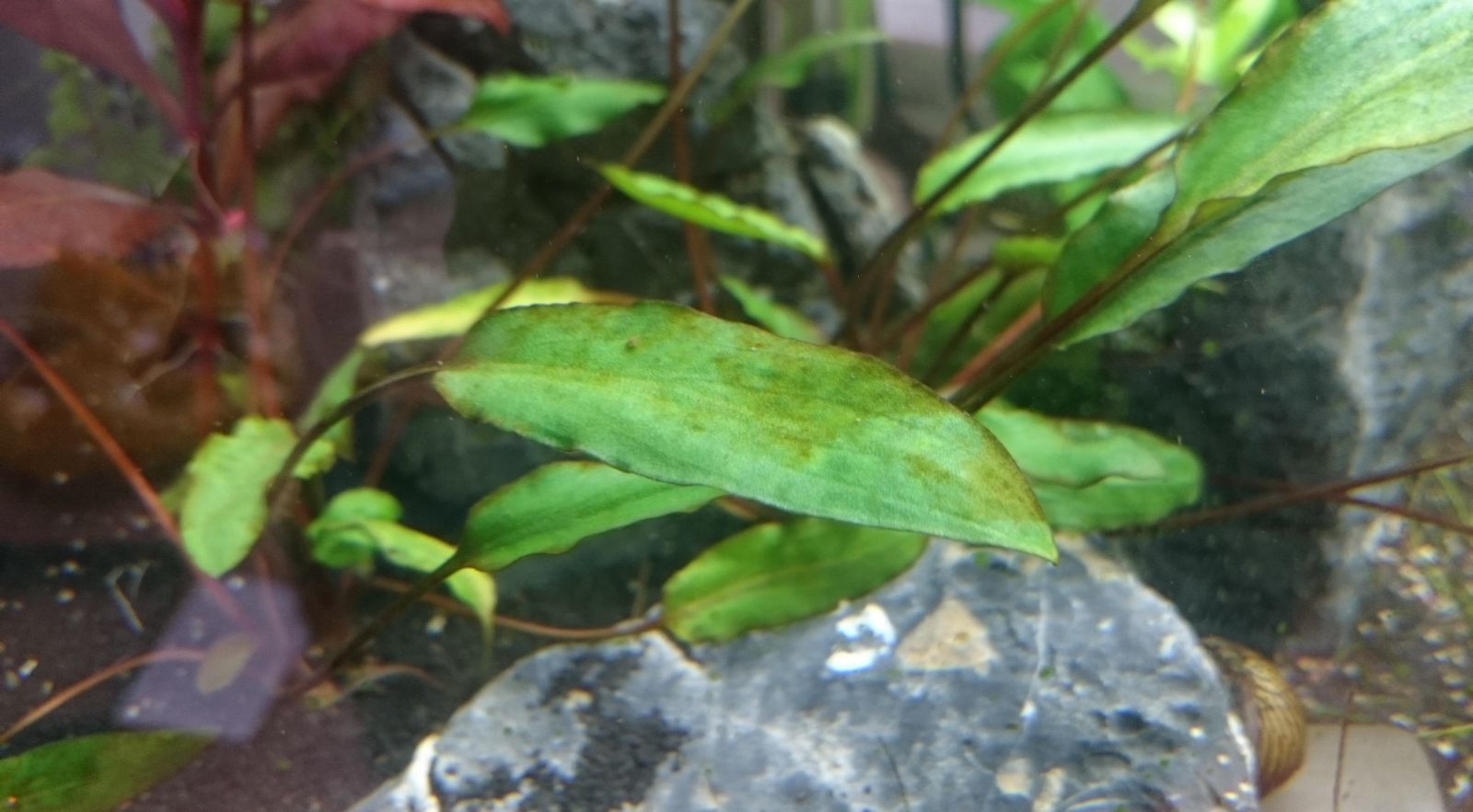
Chocolate-brown algae is also chosen Bacillariophyceae. They often form dark-brown coats that comprehend all the surfaces in the aquarium. They're called chocolate-brown algae due to their colour, all the same, this is non quite right, equally true brown algae are a different group that is practically exclusively found in marine waters. Frequently, diatoms grade during the kickoff few weeks in the life of a new aquarium, and in most cases, they get every bit they came - all past themselves. For more information, please go to this commodity.
Blueish-green algae (BGA)
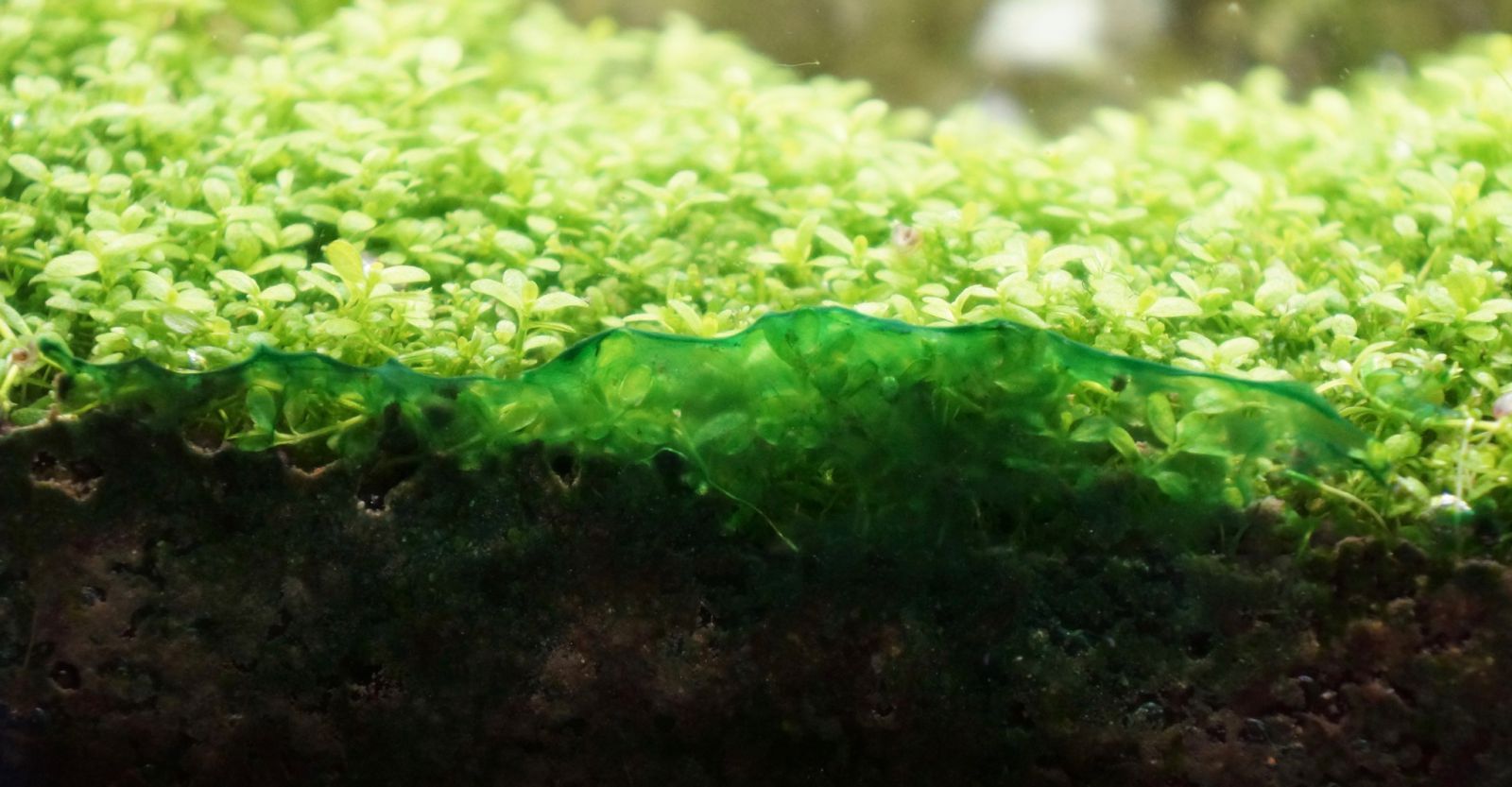
From a biological point of view, these slimy, blueish-green coats are no algae at all, but cyanobacteria (blue bacteria). They grow as a film on plants and decoration and are easy to place thanks to their strong, foul smell. Y'all tin often find them in the substrate on the aquarium glass (equally y'all tin meet in the photo). For more than information about blue-green algae please go to this article.
Greenish spot algae (GSA)

Green spot algae (probably most always species of the Coleochaete family unit) are green, spot-like algae that commonly grow on the aquarium glass and sometimes on ornament and on the leaves of aquatic plants. They are oftentimes found in strongly-lit tanks. These algal crusts are hard to remove from the glass, you'll demand a blade cleaner to practise so. For more than data on spot algae, delight go to this article.
Light-green grit algae (GDA)

Greenish dust algae resemble other hard algal films, however, if you touch them they are somewhat slimier and can be removed easily simply by wiping or by water motion. If you try to remove them manually, you'll have a dark-green dust in the water, which settles after a few hours, forming new films. Those algae are very obnoxious, and some people in Germany have called them "dark-green glass pest". This term has been coined in the aquatic institute forum flowgrow.de, however, the exact species of this algae is nevertheless unknown. In this article you can discover out more well-nigh them.
Other green algae coats

The common dark-green algae coats that volition form on all the surfaces in the tank are pretty much harmless. In contrast to spot algae, their growth habit is wider. They will cling to the surface more than or less firmly, some of them tin be removed manually. We have collected farther information about these algae hither.
Gratuitous-floating algae
These algae bladder in the water. They tin can cause considerable clouding. Turbid water may also exist caused past a bacterial bloom, though.
Green h2o



Green water is acquired by tiny, free-floating algae that add together a greenish stain to the water but practice not settle on hard surfaces. Usually they belong to the genus Chlorella. In this article yous can discover out more than most them.
Bacterial bloom


Merely like dark-green h2o, a bacterial bloom can deject the water in the aquarium considerably. However, the water is non green just of a milky light gray. This phenomenon is not due to an infestation with algae merely to strong bacterial growth. For farther information, please jump to this commodity.
Green filamentous algae
Here we have a compilation of the most common green algae in freshwater aquaria that grow in filamentous form (in unlike lengths). Their growth habits differ somewhat.
Greenish thread algae

Dark-green thread algae consist of long dark-green filaments. There are several species that grow like this. These filaments are rather soft and not very sturdy. Their base does not attach strongly to the substrate just the filaments wrap effectually plants or ornamentation. You can utilize a chopstick to wind them and to manually remove them. A decent number of Amano shrimp will help keep thread algae in cheque. For more information about thread algae, please go to this article.
Fluff algae
These light greenish algae course very soft, cottony cushions. They can grow to a length of around four cm. There are several algae species with this growth habit. Algae eaters like Amano shrimp munch on them and keep them in check very reliably.
Fuzz algae

These green algae grow in the class of individual short filaments, mainly on the leaves of aquatic plants or on decoration. This algae tin exist controlled quite hands if you lot optimise your fertilising regimen. For more information about these algae please jump to this commodity.
Hair algae
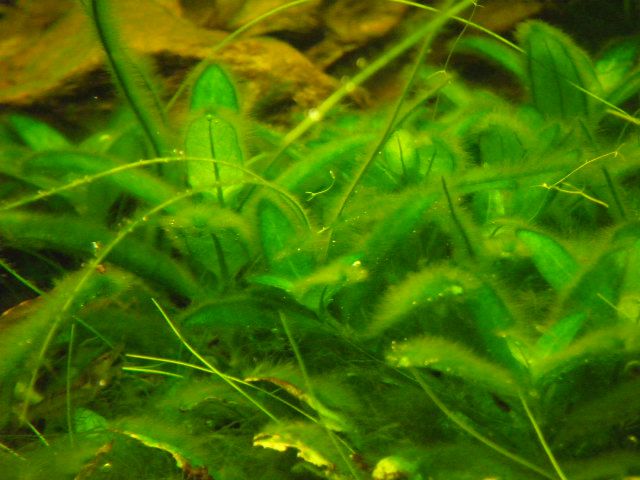
Hair algae class dense coats on plants and hardscape and can form very quickly. Depending on the species, the filaments will grow to unlike lengths. Hair algae are difficult to remove mechanically every bit they anchor their base very tightly to the substrate. Quite frequently these algae belong to the genus Oedogonium. Hither nosotros have gathered more than information on hair algae.
Cladophora sp.

One of the nigh obnoxious green algae belongs to the genus Cladophora (reticulated algae). It is easy to diagnose every bit information technology branches visibly, which leads to a bushy growth habit. It is harder than other filamentous algae and is not as attractive a food source for algivores than other algae species. For further information please become to this article.
Source: https://www.aquasabi.com/aquascaping-wiki_algae_algae-in-the-aquarium
Posted by: charlesmistabou.blogspot.com


0 Response to "Is It Ok To Keep Algae On Branches In Aquarium"
Post a Comment